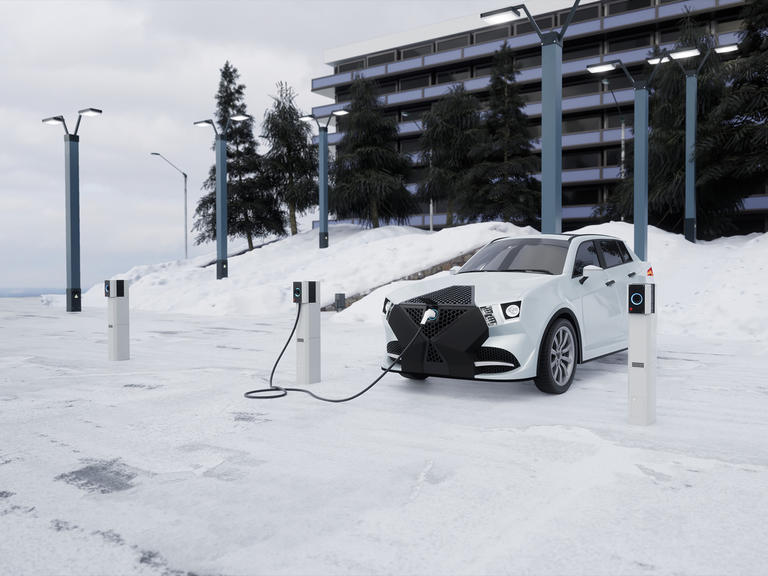The impact of climate change on electric vehicles

Electric vehicles are designed to mitigate environmental changes but can they withstand a world of weather extremes?
The transition from gasoline to electric vehicles (EVs) arrived with the promise of reducing carbon emissions.
But as climate change intensifies and global temperatures rise, carmakers are looking for ways to make their EVs more resilient in severe weather and maintain the momentum toward a greener future in transportation.
EVs don't like it hot
When temperatures soar, electric cars face unique challenges. This is because, unlike conventional cars that rely on combustion engines, electric vehicles depend solely on batteries.
And these batteries, particularly lithium-ion and lithium-iron-phosphate types, are sensitive to temperature changes.
Each EV battery is powered by tiny particles called electrons that move through its wires to create electricity. In hot weather, battery performance can decline because higher temperatures cause the electrons to slow down, resulting in reduced power availability.
For example, when temperatures climb above 95° Fahrenheit (or 35° Celsius), an EV’s range can drop by up to 15%. This is especially important for drivers who are planning long trips or live in hot climates.
Hot weather can affect EVs even when they're not moving.
Most drivers know parking in shaded areas is always a good idea but this is especially true for EVs. The lack of a combustion engine in these cars means there is no efficient way to disperse the heat generated by the battery.
To avoid overheating and maintain better range, it's best to start a trip fully charged. Powering up during cooler hours can also help, as the charging process generates heat that can make the problem worse in peak temperatures.

Charging through chillier climes
Cold temperatures also pose challenges for EVs, affecting battery efficiency and how far the vehicle can go.
Similar to heat, the cold also reduces the battery output by slowing down its chemical reactions. On average, an EV’s range can decrease by 20% at 32° Fahrenheit (or 0° Celsius), and if the mercury drops to 22° Fahrenheit (or -5° Celsius), the distance traveled can drop by up to 40%.
The energy consumption in cold weather also increases as the vehicle’s heating system draws power from the battery, further reducing the driving range.
A solution for this is reheating the EV while it's still plugged into the grid, which can conserve battery capacity because the energy used for heating won't come from the battery itself.
Charging is also affected. When batteries are cold, they can't accept the same rate of charge, causing longer charging times. To mitigate this issue, most modern EVs come equipped with thermal management systems that help maintain battery performance even in cold weather.

The winds of range
Both extreme heat and cold can significantly affect how far electric vehicles can go. But it’s not just the temperature that impacts electric cars.
Other environmental factors also play a role. Headwinds can increase air resistance, requiring more energy from the battery and reducing range, while tailwinds can improve it by easing the load on the battery.
Icy roads present another challenge. Traction control systems have to work harder to maintain grip, consuming more power and reducing the achievable distance - the increased rolling resistance from snow or slush compounds this effect.
Driving at slower speeds on icy roads is safer but can also be less energy-efficient, further decreasing the battery's durability.

Plugging in
Despite these challenges, EV technology continues to evolve. Advances in battery management systems and routing tools can help drivers optimize their travel plans and conserve energy.
For instance, applications like HERE EV Routing allow drivers to plan trips by considering battery range, elevation changes and charging station locations.
This allows drivers to plan trips that maximize efficiency and minimize downtime, considering traffic conditions and topography and ensuring they find the nearest charging points when needed.
Another solution that supports drivers in locating the nearest charging stations is HERE EV Charge Points. This tool provides real-time availability updates and displays essential information about each charging point, such as charging speed and connector types to ensure drivers can recharge vehicles conveniently and efficiently during their journeys.

Seasonal sustainability
EVs offer a sustainable alternative to traditional cars, but they aren't immune to the impacts of climate change.
The future of electric vehicles in a warming world is promising, but it requires adaptation and awareness. Understanding how temperature extremes affect EV performance is critical for anyone considering buying an electric car.
By being aware of how hot and cold weather influences battery efficiency and range, drivers can take proactive steps to mitigate these effects.
Have your say
Sign up for our newsletter
Why sign up:
- Latest offers and discounts
- Tailored content delivered weekly
- Exclusive events
- One click to unsubscribe



